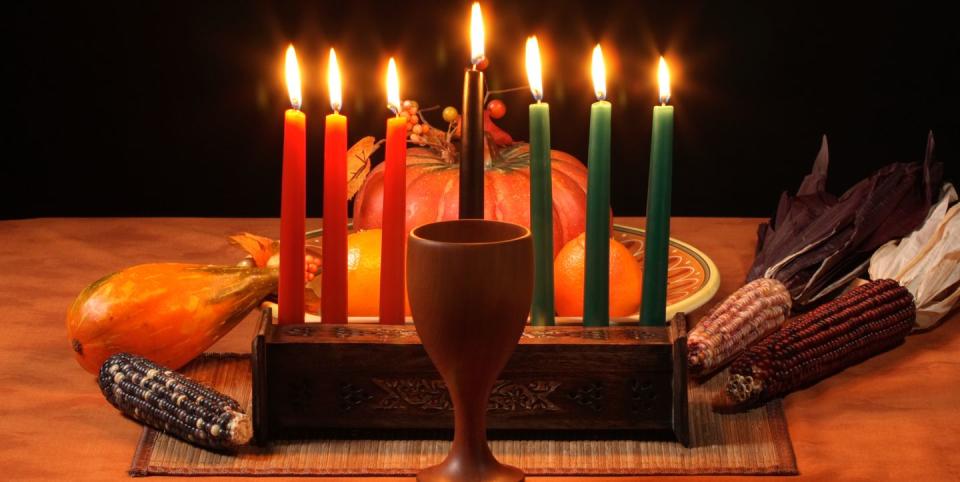5 Kwanzaa Traditions You Should Know

You probably already know that Kwanzaa, which kicks off on December 26th each year, celebrates African heritage and culture. But did you know that it was started by a California doctor, or that it didn’t exist until 1966?
Created by Dr. Maulana Karenga—a professor and chairman of Africana Studies at California State University, Long Beach—the spirited holiday was meant to foster a sense of togetherness within African-American communities in Los Angeles following the 1965 Watts Rebellion. Karenga mixed elements of different African harvest traditions to form the foundation of Kwanzaa, derived from the Swahili phrase matunda ya kwanza (which means “fresh fruits"). (The extra "a" in the holiday's name was added to accommodate seven children at the very first Kwanzaa celebration, each of whom represented a letter.)
Kwanzaa isn’t a religious affair, but one steeped in family and tradition. It’s rooted in Nguzo Saba: seven pillars curated by Karenga, which include Kujichagulia (self-determination), Ujima (collective work and understanding), Ujamaa (cooperative economics), Nia (purpose), Kuumba (creativity)—and lastly, Imani (faith).
Read on for everything you need to know about honoring and celebrating the thoughtful holiday of Kwanzaa, which invites people of all creeds to partake in the festivities!
Setting the Stage
Every Kwanzaa celebration centers on the kinara, (a seven-stick candleholder similar to a menorah used for Hanukkah). Rest it on a straw mat (or mkeka), alongside a basket filled with fruits and vegetables (mazao), a communal cup (kikombe), and gifts (zawadi). Place ears of corn (muhindi)—one for every child in the family—beneath the kinara.
In decorating your home for Kwanzaa, be sure to highlight the holiday's three colors: green (a symbol of Africa's rich land and hope for the future), black (representing people of African descent), and red (which stands for their struggle).
Candle Ceremony and Reflection
Each day during the week-long celebration, families gather to ignite one of seven candles on the kinara. Collectively known as Mishumaa Saba, the candles each represent a key tenet of Kwanzaa.
On the first day, celebrants light the black center candle (flanked by three red and three green candles) and talk about the importance of the first principle, Umoja: “to strive for and maintain unity in the family, community, nation, and race.” The second night honors Kujichagulia, which Karenga has said: “reaffirms the right of persons and peoples to determine their own destiny and daily lives, to live in peace and security, and to flourish in freedom everywhere.” The ritual repeats every evening through January 1st, with each candle lighting followed by a meaningful discussion on the significance of that day’s honored principle.
Music plays a very important role in the festivities, which showcase traditional African tunes and instruments—from bougarabous and djembes to zezes and shekeres—so don't forget to prep a playlist!
The Feast
Kwanzaa culminates with Karamu Ya Imani, a shared feast held on December 31st. A Karamu spread typically features a mix of traditional African dishes. Common offerings include one-pot recipes that spotlight fruits and meats (such as jambalaya, Senegalese thieboudienne, West Indian curry, Ghanaian groundnut stew, and Nigerian jollof rice) paired with myriad starches like plantains, couscous, buttermilk biscuits, and candied yams. You can also incorporate Southern comfort food into the mix (think: collard greens, fried okra, cornbread muffins, and black-eyed peas).
On New Year's Day, families exchange gifts (which, per tradition, are usually handmade). Popular presents include hand-woven quilts and mkeka, scrapbooks, ornaments, and beaded jewelry.
Celebrating with Kids
There are plenty of ways to get the little ones excited about Kwanzaa, from getting them involved in Kuumba preparations to letting them light the candles (with a grownup’s help, of course!).
Children are encouraged to partake in arts and crafts during the festivities, from making a kinara out of an egg carton to creating an African drum using a plant pot. (Looking for more ideas? Here’s a roundup of fun Kwanzaa projects kids will love, courtesy of Artsy Craftsy Mom.)
Follow House Beautiful on Instagram.
You Might Also Like

